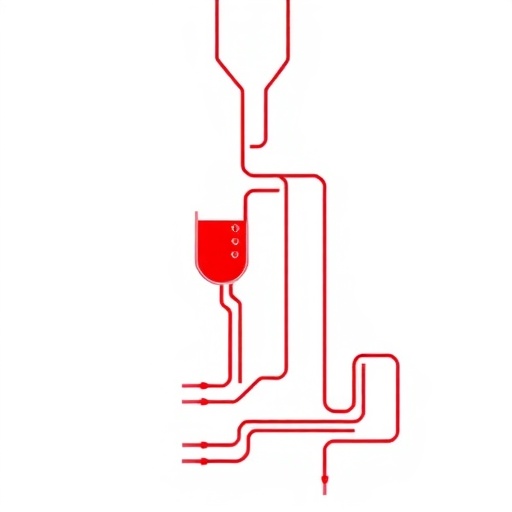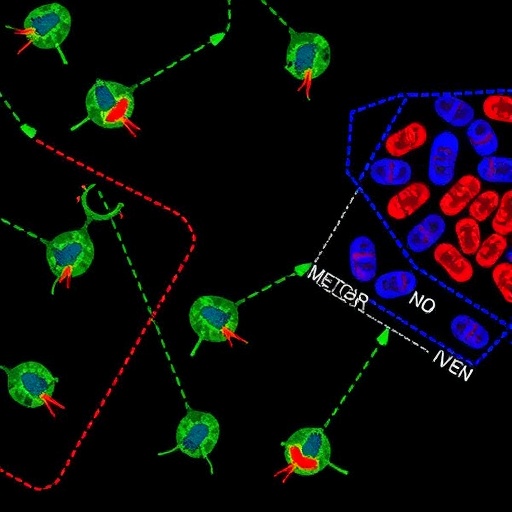In the intricate dance of maintaining bodily homeostasis, thirst regulation stands as a pivotal process ensuring survival. Traditionally, it has been understood that drinking behavior is governed by homeostatic mechanisms responding to changes in blood osmolality—a physiological cue indicating when the body requires hydration. However, a growing body of research challenges this feedback-only model by illuminating the phenomenon of “anticipatory thirst satiation,” a regulatory process that adjusts drinking behavior well before measurable changes in blood composition occur. This early, preemptive control mechanism effectively fine-tunes fluid intake, preventing both excessive hydration and the deleterious consequences that can follow. Despite its importance, the neural circuits mediating anticipatory signals, especially those relaying peripheral information ahead of blood changes, have remained enigmatic.
Now, breakthrough research from Xu, L., Sun, Y., Huang, C., et al., published in Nature Neuroscience in 2025, offers compelling evidence delineating a novel neural pathway engaged in anticipatory drinking behavior. Their work uncovers an inhibitory circuit originating in the medial septum (MS) and projecting to the subfornical organ (SFO), a circumventricular structure known for its critical role in fluid homeostasis. The MS—a region traditionally associated with theta rhythm generation and hippocampal regulation—contains γ-aminobutyric acid (GABA)-producing neurons that, as this study reveals, encode complex water-satiation signals by integrating sensory inputs from the oral cavity along with dynamic gastrointestinal feedback. This metabolic and sensory integration by MS GABAergic neurons crafts a preemptive signal that modulates the activity of excitatory CaMKII-positive neurons in the SFO, sculpting thirst behavior in an anticipatory manner.
Intriguingly, the study illuminates the bottom-up nature of this regulatory pathway. The medial septum neurons do not operate in isolation but receive afferent input from the parabrachial nucleus (PBN), a brainstem structure historically implicated in visceral sensory processing and homeostatic regulation. The PBN, by virtue of its relay function, conveys multisensory information—including taste and gut-derived signals—that the MS neurons then filter and integrate. This multilayered sensory convergence enables the MS-SFO circuit to detect subtle peripheral signals indicating water ingestion or gastrointestinal distension before any systemic osmotic changes manifest, thus initiating timely satiety signaling.
Methodologically, the authors employed a sophisticated blend of viral tracing, optogenetics, and calcium imaging in murine models. Through targeted manipulation of MS GABAergic neurons, researchers demonstrated that silencing this inhibitory pathway led to dysregulated drinking behavior characterized by excessive water intake. This maladaptive hyperdipsia resulted in hyponatremia—a dangerous electrolyte imbalance underscoring the circuit’s vital role in preventing overhydration. Conversely, artificial activation of MS inhibitory neurons effectively curtailed thirst drive, further reinforcing their functional significance in anticipation-based fluid regulation.
Beyond the immediate ramifications for thirst control, these findings carry broad implications for understanding central nervous system circuits that perform pre-emptive homeostatic modulation. Rather than relying solely on feedback mechanisms responsive to systemic physiological alterations, the brain exploits a rich tapestry of sensory cues to dynamically govern behaviors essential for internal balance. The identification of a septal inhibitory pathway integrating oral and gastrointestinal inputs refines the canonical thirst circuitry model and positions the medial septum as an unexpected yet critical node in fluid homeostasis.
Moreover, this work bridges gaps in prior knowledge regarding the SFO’s afferent modulation. The subfornical organ has been a focal point for studying osmoreception due to its unique access to circulating factors within the blood, yet how it receives presystemic sensory information remained unclear. The delineation of an MS→SFO inhibitory circuit enriches our understanding of how anticipatory signals gate the excitatory output of SFO neurons, those CaMKII-expressing populations known to trigger drinking behavior. By dampening SFO excitation preemptively, the medial septum ensures a calibrated thirst response that avoids redundancy and potential overconsumption.
The evolutionary advantage of such anticipatory control is clear. Drinking is a vital, yet potentially risky behavior if misregulated; both dehydration and overhydration can compromise physiological integrity dramatically. The elucidated circuit allows animals to adjust intake rapidly in response to immediate external inputs—oral sensations of fluid ingestion and gastrointestinal feedback—thus optimizing hydration status in real time rather than relying on delayed systemic feedback. This swift neural computation prevents osmotic excursions and maintains electrolyte homeostasis critical for normal cellular and neurological function.
While the parabrachial nucleus is classically regarded as a hub integrating homeostatic and nociceptive signals, this research highlights its role in conveying nuanced presystemic sensory information upstream to higher brain centers involved in motivational and behavioral regulation. The parabrachial’s influence over medial septal inhibitory neurons underscores a complex, layered architecture that processes transient peripheral cues to refine central thirst circuits. These findings encourage a reevaluation of the parabrachial nucleus’s role beyond reflexive autonomic regulation, emphasizing its participation in anticipatory behavioral modulation.
This study also brings to light potential clinical implications. Conditions characterized by disturbed fluid intake or electrolyte imbalances, such as psychogenic polydipsia or hyponatremia in hospitalized patients, might involve disruptions within this newly identified septal pathway. Understanding the precise neural underpinnings governing anticipatory thirst could yield novel therapeutic targets, potentially providing interventions that recalibrate inappropriate drinking behaviors before overt physiological derangements occur.
Interestingly, the medial septum’s classical function in modulating hippocampal theta rhythms links neural oscillations traditionally associated with cognition to visceral physiological regulation. This dual role may reflect integrative mechanisms where internal bodily states influence cognitive and affective processes—a fertile avenue for future research exploring how homeostatic drives are embedded within larger brain network dynamics and influence motivational states tied to survival.
The confirmation that medial septal GABAergic neurons directly inhibit CaMKII-positive SFO neurons provides a mechanistic substrate for the finely tuned control of thirst. By controlling excitatory output within the SFO, the medial septum exerts a gating influence on thirst-promoting circuits, preventing excessive water intake before systemic hydration levels necessitate immediate counteraction. This fine balance between excitation and inhibition within the thirst circuitry underscores neural precision in homeostatic behaviors.
By connecting mouth-to-gut signals with central processing nodes, this bottom-up pathway reveals an elegant neural strategy for integrating multimodal sensory inputs relevant to drinking behavior. The study elegantly showcases how anticipatory control mechanisms are not only theoretical concepts but are realized through discrete, identifiable circuits that preemptively balance fluid intake with the body’s needs. This prevents the potentially deleterious lag inherent in strictly feedback-driven thirst regulation.
Future research building on this foundational work may explore how other peripheral cues, such as hormonal signals or mechanoreceptor activation in the gut, converge onto the medial septum and related circuits. Extending these findings could uncover broader anticipatory regulatory systems managing other homeostatic drives including feeding, thermoregulation, or energy balance, illustrating a generalized neural principle of preemptive behavioral control.
Additionally, the intersection of septal pathways with other neuromodulatory systems governing arousal, reward, and motivation invites exploration into how thirst satiation signals interact with broader brain states and behavioral repertoires. Such cross-talk may illuminate how hydration status modulates attention, affect, and cognitive performance through septal-hippocampal circuits, weaving physiology into the fabric of everyday mental functioning.
In conclusion, Xu and colleagues have uncovered a previously unrecognized bottom-up septal inhibitory circuit that plays a pivotal role in mediating anticipatory control of drinking behavior. By integrating oral and gut-derived sensory cues through the medial septum to the excitatory neurons of the subfornical organ, this pathway prevents overhydration by dampening thirst drive before systemic blood osmolality changes arise. This work not only advances the fundamental neuroscience of thirst but also opens novel avenues for understanding how the brain orchestrates complex homeostatic phenomena through anticipatory neural architecture.
Subject of Research: Neural circuitry underlying anticipatory thirst regulation and homeostatic drinking behavior.
Article Title: A bottom-up septal inhibitory circuit mediates anticipatory control of drinking.
Article References:
Xu, L., Sun, Y., Huang, C. et al. A bottom-up septal inhibitory circuit mediates anticipatory control of drinking. Nat Neurosci (2025). https://doi.org/10.1038/s41593-025-02056-4
Image Credits: AI Generated
Tags: anticipatory drinking behaviorblood osmolality and hydrationGABA-producing neurons in thirst controlhomeostatic vs anticipatory drinkingmedial septum and subfornical organ connectionNature Neuroscience research findingsneural circuits in fluid homeostasisneuroscience of drinking behaviorphysiological cues for hydrationpreemptive fluid intake regulationpreventing excessive hydrationthirst regulation mechanisms





